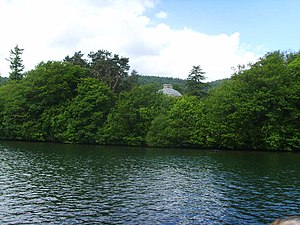Belle Isle: Difference between revisions
Created page with "{{county|Westmorland}} thumb|300px|Belle Isle, with the Round House is just visible behind the trees '''Belle Isle''' is the..." |
No edit summary |
||
| Line 1: | Line 1: | ||
{{county|Westmorland}} | {{county|Westmorland}} | ||
[[File:Belle Isle - geograph.org.uk - 451714.jpg|thumb|300px|Belle Isle, with | [[File:Belle Isle - geograph.org.uk - 451714.jpg|thumb|300px|Belle Isle, with Belle Isle House just visible behind the trees]] | ||
'''Belle Isle''' is the largest of 18 islands on [[Windermere]], a [[Lake District]] mere belonging to [[Westmorland]], and the only one ever to have been inhabited.<ref name="golakes.co.uk">{{cite web|url=http://www.golakes.co.uk/windermere/windermere-history.aspx|title=History of Windermere and Bowness|publisher=Go Lakes|date=8 April 2015}}</ref> It is ⅔ mile in length. Belle Isle House was built in 1774 to designs by John Plaw. It is unusual in that it is circular in plan, built of brick, three floors high with a four-column portico; it draws closely on the Pantheon in Rome.<ref>{{cite web|url=http://www.lake-district.gov.uk/index/enjoying/windermere/windermere_outonthelake/windermere-islands.htm|title=Windermere Islands|publisher=Lake District National Park}}</ref><ref>{{cite web|url=http://www.thecumbriadirectory.com/Tourist_Attractions/Historic_Houses_and_Buildings/house_view.php?house=belle_isle_round_house |title=Belle Isle Round House|publisher=The Cumbria Directory}}</ref> | '''Belle Isle''' is the largest of 18 islands on [[Windermere]], a [[Lake District]] mere belonging to [[Westmorland]], and the only one ever to have been inhabited.<ref name="golakes.co.uk">{{cite web|url=http://www.golakes.co.uk/windermere/windermere-history.aspx|title=History of Windermere and Bowness|publisher=Go Lakes|date=8 April 2015}}</ref> It is ⅔ mile in length. Belle Isle House was built in 1774 to designs by John Plaw. It is unusual in that it is circular in plan, built of brick, three floors high with a four-column portico; it draws closely on the Pantheon in Rome.<ref>{{cite web|url=http://www.lake-district.gov.uk/index/enjoying/windermere/windermere_outonthelake/windermere-islands.htm|title=Windermere Islands|publisher=Lake District National Park}}</ref><ref>{{cite web|url=http://www.thecumbriadirectory.com/Tourist_Attractions/Historic_Houses_and_Buildings/house_view.php?house=belle_isle_round_house |title=Belle Isle Round House|publisher=The Cumbria Directory}}</ref> | ||
Latest revision as of 19:41, 15 May 2017

Belle Isle is the largest of 18 islands on Windermere, a Lake District mere belonging to Westmorland, and the only one ever to have been inhabited.[1] It is ⅔ mile in length. Belle Isle House was built in 1774 to designs by John Plaw. It is unusual in that it is circular in plan, built of brick, three floors high with a four-column portico; it draws closely on the Pantheon in Rome.[2][3]
The Roman governor at Ambleside built a villa on the island. In 1250 it was the seat of the district's Lord of the Manor.[1] It was also a Royalist stronghold during the English Civil War.[1]
In 1774 an unusual circular Belle Isle House was erected on the island, which was sold along with the island to the wealthy Curwen family who renamed the island after their daughter, Isabella.[1] it was then sold on to Isabella Curwen by her family in 1781 for £1,720 and was permanently renamed after her.[4] The descendants of Isabella and her husband John Christian Curwen lived on the island until 1993.[1]
It is called 'Bell Island'[1][4] not 'Isabella Island' because of use of the shortened form of Isabella- Bella, which lost the 'a' to become 'Bell', spelt 'Belle' by the Ordnance Survey map of 1925 over the years. It was known locally as the Great Island or Long Holme[1][4] and formerly known as Longholm, before its renaming in 1774.[1]
In 1996, Belle Isle House suffered serious damage following a large fire. However, it was repaired and is once again a place of residence.[5]
References
- Location map: 54°21’43"N, 2°56’4"W
- ↑ 1.0 1.1 1.2 1.3 1.4 1.5 1.6 1.7 "History of Windermere and Bowness". Go Lakes. 8 April 2015. http://www.golakes.co.uk/windermere/windermere-history.aspx.
- ↑ "Windermere Islands". Lake District National Park. http://www.lake-district.gov.uk/index/enjoying/windermere/windermere_outonthelake/windermere-islands.htm.
- ↑ "Belle Isle Round House". The Cumbria Directory. http://www.thecumbriadirectory.com/Tourist_Attractions/Historic_Houses_and_Buildings/house_view.php?house=belle_isle_round_house.
- ↑ 4.0 4.1 4.2 "The islands of Windermere". BBC. July 10, 2006. http://www.bbc.co.uk/cumbria/content/articles/2006/07/10/windermere_islands_2006_feature.shtml.
- ↑ "Journeying Through Time on Lake Windermere". timetravel-britain.com. http://www.timetravel-britain.com/articles/country/lake.shtml.